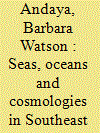| Srl | Item |
| 1 |
ID:
119860


|
|
|
|
|
| Publication |
2012.
|
| Summary/Abstract |
The seven billion humans on planet Earth consume 49,400 trillion cubic feet (1.4 quadrillion liters) of oxygen every year, enough to fill seven million Hindenburgs. About half of this oxygen comes from the ocean. Yet the recently concluded, decade-long Census of Marine Life reports that phytoplankton have been decreasing by approximately 1 percent every year since 1900. These microscopic plants produce most of the oxygen that comes from the sea. The exact causes of this decline are unknown, but rising temperatures are suspect. Ocean oxygen production is now likely about one-third of historical levels. In 2050, just as the world's population is projected to hit a peak of nine billion people, phytoplankton will be down to 22 percent of historical averages.
|
|
|
|
|
|
|
|
|
|
|
|
|
|
|
|
| 2 |
ID:
155459


|
|
|
|
|
| Summary/Abstract |
This article discusses the changing spirit world of maritime communities in Southeast Asia by differentiating ‘oceans’ from ‘seas’ and by linking historical evidence to modern anthropological studies. Since the lives of seagoing peoples are fraught with unpredictability, propitiation of local sea spirits was a traditional means of ensuring good fortune and protection. As long-distance voyages expanded in the early modern period, the global reach of the world religions, extending beyond familiar seas into the more extensive ocean environment, held out particular appeal. Not only were the gods, deities and saints attached to larger religious systems themselves ocean travellers; in contrast to the unpredictability of indigenous spirits, they were always amenable to requests for help, even when the suppliant was far from home waters. At the same time, as world religions were incorporated into indigenous cosmologies, maritime peoples gained greater agency in negotiating relationships with the local spirits that still wield power in Southeast Asian seas.
|
|
|
|
|
|
|
|
|
|
|
|
|
|
|
|